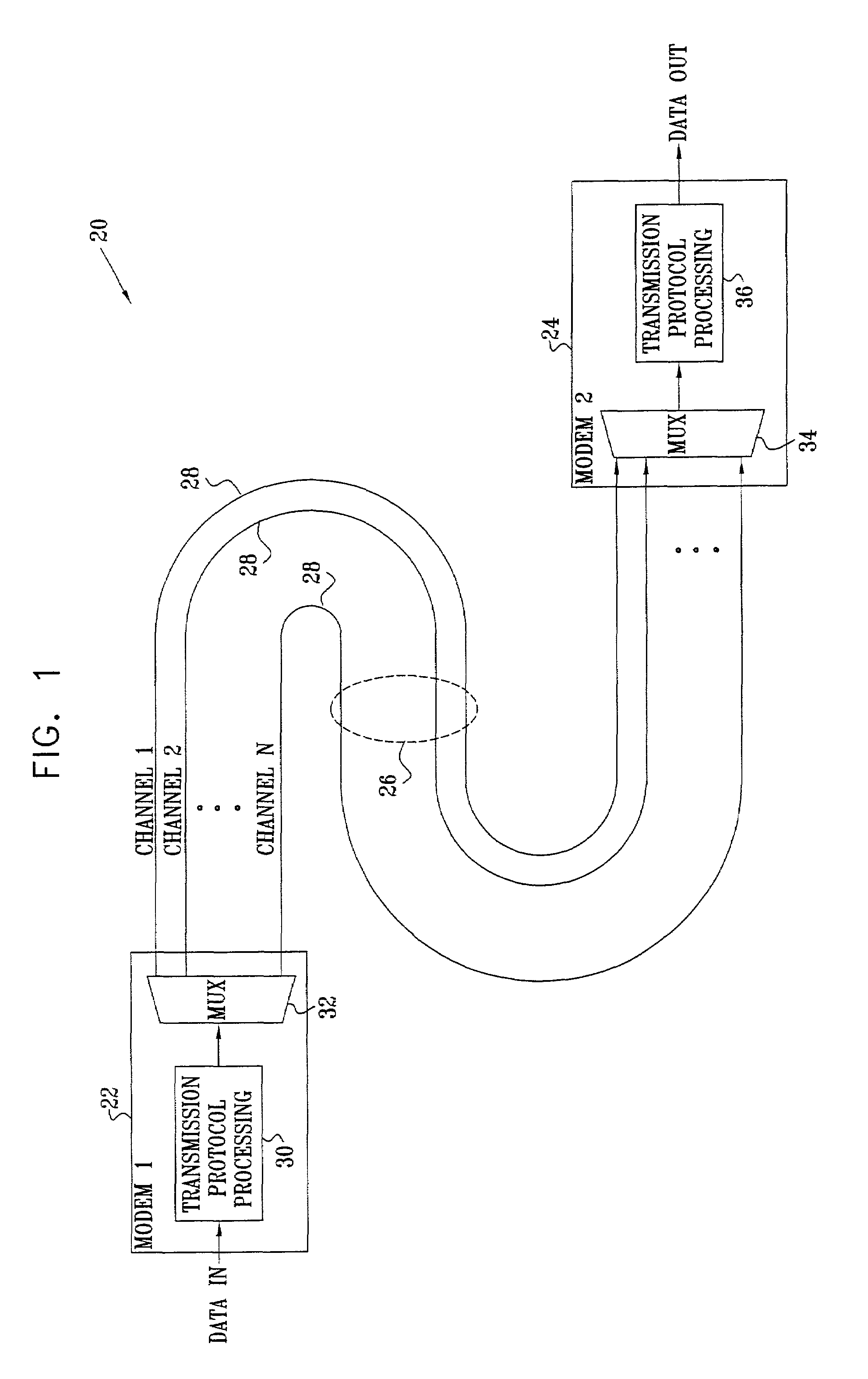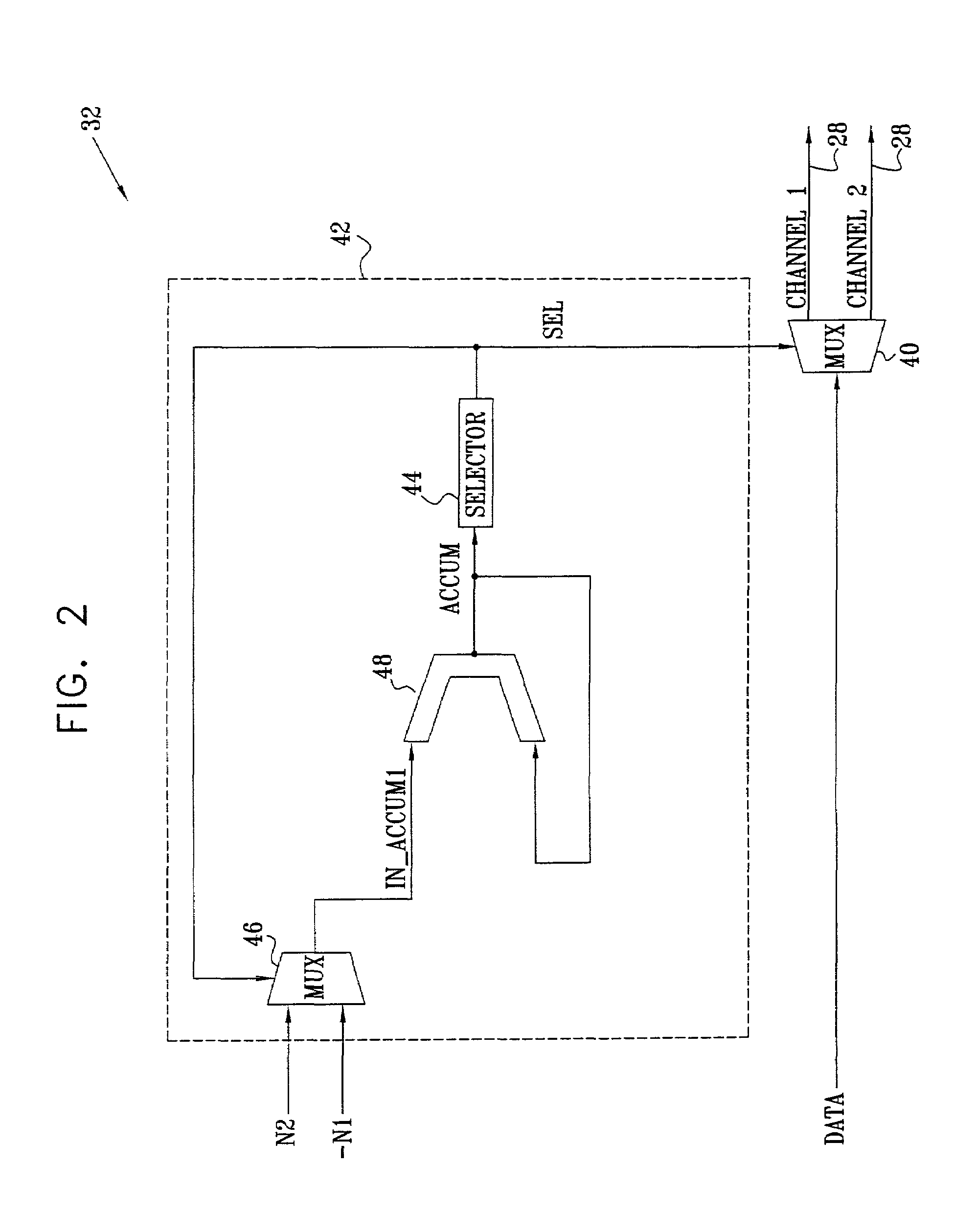Data partitioning for multi-link transmission
- Summary
- Abstract
- Description
- Claims
- Application Information
AI Technical Summary
Benefits of technology
Problems solved by technology
Method used
Image
Examples
example 1
[0079]In this case, the splitting is based on three (M−1)-entry arrays: A[i], C1[i] and C2[i]. A[i] is an accumulator identified with the ith two-way splitter 50, which is updated for each incoming data byte. C1[i] and C2[i] are constants used in incrementing and decrementing the ith accumulator. These constants are pre-calculated during system initialization, and should be updated any time there is a change in at least one subchannel rate. C1[i] and C2[i] are calculated as follows:
[0080]
For i = M / 2 to M−1C1[i] = R[2*i−M+1]C2[i] = R[2*i−M+2]For i = M / 2−1 to 1 (a decreasing index in steps of −1)C1[i] = C1[2*i] + C2[2*i]C2[i] = C1[2*i+1] + C2[2*i+1]
In these calculations, when K
[0081]To begin operation of the multiplexer, all the accumulators A[i] are set to zero. The following calculation is then performed for every incoming data byte:
[0082]
{k = 1For i=1 to L{If (A[k]≧ C1[k]){A[k] = A[k]− C1[k]sel = 1}else{A[k] = A[k] + C2[k]sel = 0}k ...
example 2
[0083]In this method, unlike the preceding one, accumulators A[i] are associated with respective subchannels 28, for i=1, . . . , K, along with a single array of constant parameters C[i]. The parameters C[i] are pre-calculated during system initialization and are updated any time there is a change in at least one of the subchannel rates. In this example, each C[i] is simply set equal to G / R[i], wherein G is the least common multiple (LCM) of R1, R2, . . . RK. Alternatively, other values of G may be used. As before, all the accumulators A[i] are set to zero before beginning operation. The following calculation is then performed for each incoming data byte:
[0084]
{Find j such that A[j] = min(A[i]) over all i ≦ KA[j] = A[j] + C[j]Send data byte to subchannel no. j}
[0085]Splitters 50 are set for each byte so as to select subchannel j, as provided by this calculation. If there is more than one value of j for which A[j]=min(A[i]), the lowest of these values of j may be selected. Alternativ...
example 3
[0088]This method is similar to that described in Example 2, but uses a scaling factor h to keep the accumulator values A[i] within a relatively small range. The parameters C[i] are pre-calculated as in Example 2. Preferably, h is the subchannel index such that C[h]=min(C[i]), taken over all i. Alternatively, h may be chosen to be a different subchannel index. The following calculation is performed for each incoming data byte:
[0089]
{Find j such that A[j] = min(A[i]) over all i ≦ KIf (j≠h)A[j] = A[j] + C[j]ElseA[i] = A[i]− C[j] for all i except jEndSend data byte to subchannel no. j}
[0090]FIG. 5 is a block diagram that schematically illustrates a multi-pair transmitter 60, in accordance with another preferred embodiment of the present invention. This model is similar to the standard SDSL transmitter reference configuration, as described in Chapter 4 (page 13) of the above-mentioned ETSI standard, except that it is extended to serve K subchannels 28. Typically, in SDSL configurations,...
PUM
 Login to View More
Login to View More Abstract
Description
Claims
Application Information
 Login to View More
Login to View More - R&D
- Intellectual Property
- Life Sciences
- Materials
- Tech Scout
- Unparalleled Data Quality
- Higher Quality Content
- 60% Fewer Hallucinations
Browse by: Latest US Patents, China's latest patents, Technical Efficacy Thesaurus, Application Domain, Technology Topic, Popular Technical Reports.
© 2025 PatSnap. All rights reserved.Legal|Privacy policy|Modern Slavery Act Transparency Statement|Sitemap|About US| Contact US: help@patsnap.com



